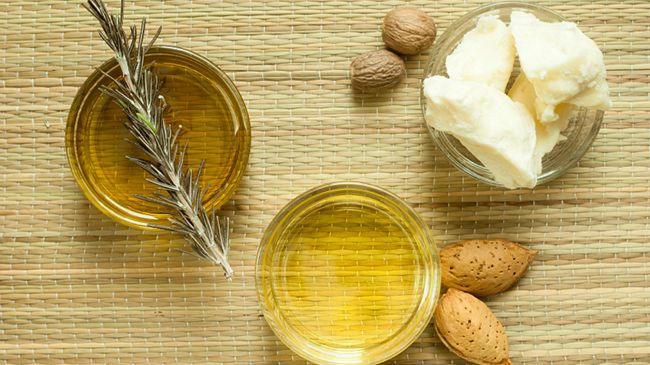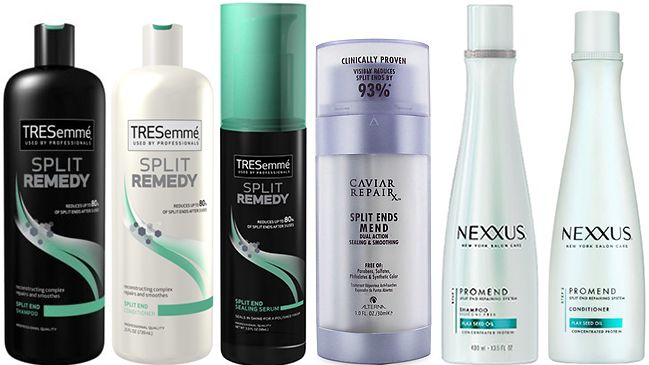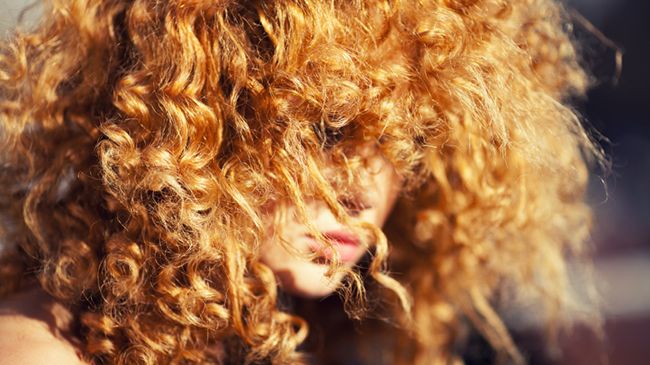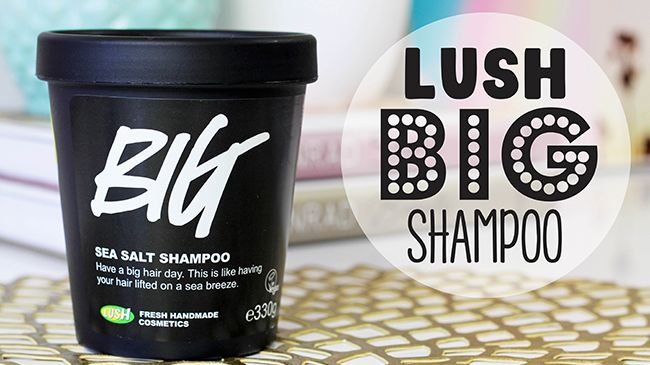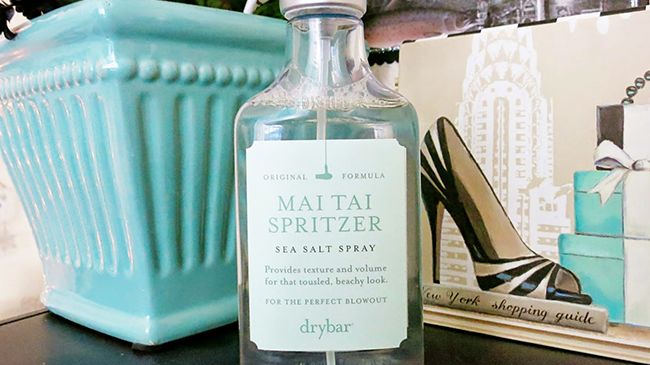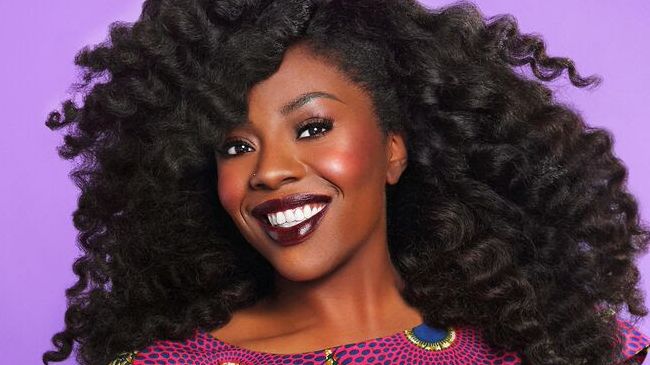Search Results: Sabrina Perkins

How does lecithin help with hair?
Lecithins are emulsifiers that are surface-active and water-loving. These fatty substances are often found in hair and skin products because of their main nutrients: choline and insotil. Choline and inositol are both important for healthy hair growth, as they are part of the B complex vitamins. Lecithin supports and enhances the required amount of protein for hair growth while improving the texture and look of hair by adding shine or luster. Its high concentration of fatty acids creates a barrier on the skin and hair that effectively captures and seals in moisture.
This moisturizing benefit makes lecithin perfect for persons suffering from dry, brittle hair. It adds shine, seals in moisture, and restores hair’s natural protective coating often damaged by styling, chemical applications, heat, or environmental changes. This is often why we find shampoos and conditioners utilizing lecithin to help improve the look and structure of damaged hair. Lecithins also help control the viscosity of liquids and help with product absorption into the skin or hair. They are highly conditioning and moisturizing for hair conditioners and masks. Not just for conditioning and moisturizing, lecithin helps to prevent fly-away hair for our straight-haired naturals.
There are dietary supplements of lecithin and of course food sources, but if you want the benefits of this natural-occurring ingredient, then you can benefit from these products below that use the emulsifying and moistening power of lecithin in their formulas.
Products with lecithin
One of the most popular ingredients for products that claim to strengthen your hair is protein. We often see hydrolyzed proteins but when something like hydrolyzed mucopolysaccharides come along we can become overwhelmed with understanding what it means. For one we may recognize the polysaccharides and realize it has something to do with sugar. Aside from that, what exactly is hydrolyzed mucopolysaccharides and what is it doing in your hair products?
What are hydrolyzed mucopolysaccharides?
First, let’s break each component down to determine what it is and why it is in some of your hair products:
Hydrolyze: the process of hydrolyzing is an ingredient being decomposed by reacting with water.
Mucopolysaccharides: natural skin component, which are long chains of sugar molecules often found the mucus and fluid around joints. They are also known as glycosaminoglycans. –Medline Plus
Hydrolyzed mucopolysaccharides are a skin-hydrating ingredient that helps to decrease transepidermal water loss because of its strong water-binding properties. This is most beneficial for skin, as this ingredient will bind water and other cellular elements to form a matrix that holds skin cells together, creating a more supple and former texture. Mucopolysaccharides are often called “the glue of life” as they are long carbohydrate chains of sulfated amino sugars that are found at the base or roots of the evolutionary tree of all animal life. They are an integral part of the structural integrity of bone, cartilage, and elastic tissue while also aiding in modulating the viscosity of bodily fluids.
Why are hydrolyzed mucopolysaccharides important in hair products?
As you can probably guess, any ingredient that is willing to bind water to your skin and hair is a great moisturizer. Mucopolysaccharides are high in our body tissues in our youth but lessen as we age. And while it maintains flexibility of our arteries, it also preserves the elasticity of our skin (scalp included”> and retains moisture. This ingredient is easily absorbed into the scalp and adds the necessary moisture to keep the scalp from dryness and moisture loss. Suffering from a dry scalp? Check out these products.
Product recommendations
- ApHogee Keratin 2-Minute Reconstructor
- Folicure Thickening Mousse
- Mill Creek Biotene H-24 Natural Scalp Massage Emulsion
- ALTERNA Caviar Clinical Daily Root & Scalp Stimulator
What are some ingredients you would like more information on? We’re here to help so comment below.
Many curly girls love making their own spray bottle mixes. I love lavender oil and jojoba oil, so I add them in a spray bottle with my favorite conditioner to refresh my curls in the morning. I do realize that there is a time limit on my concoction, and if it has been sitting around for too long I dump and start over. Just like food, hair care concoctions have a shelf life—even with refrigeration—so many DIY concoctions require something more than refrigeration for them to last. They need preservatives.
What are preservatives and why are they necessary in hair products?
Simply put, preservatives are natural occurring or man-made chemicals that are added to food and cosmetic products to prevent spoilage. These chemicals are acidic in nature, making it difficult for organisms from mold, yeast, and bacteria to grow. They allow your products to last longer than what refrigeration is able to do alone. The downside to preservatives is that some may cause skin irritations—even the natural ones—but if creating a product to sell or if one is longing for longer shelf life, some sort of preservative may be necessary. One that is popular in hair care products and natural occurring is sorbic acid.
What is sorbic acid?
Sorbic acid is a white, crystalline powder that is an organic acid. It is derived from mountain ash berries or manufactured synthetically. It is a preservative found in many foods, contact lens solutions, and skin and hair products and very soluble in oil. According to Cosmeticsinfo.org, sorbic acid kills microorganisms or prevents their growth and reproduction, which in turn protects the product from spoiling, but it is less active against bacteria. Sorbic acid is sometimes used as a humectant and the salts in sorbic acid (calcium, potassium, and sodium”> are able to dissolve in water, but sorbic acid is much more soluble in fats and oils. It also considered a low hazard ingredient and not expected to be potentially toxic or harmful.
Now, DIYers are not the only ones who may be using a preservative that contains sorbic acid, as it is quite popular in hair products like we have listed below, but it is possible to simply buy it online on Amazon.com. If choosing to go the DIY route and looking for a preservative that is easily accessible then sorbic acid may be a good fit for you, your hair and your creation.
- Let’s Jam Shining & Conditioning Gel
- Garnier Fructis Style Brilliantine Water-Based Shine Wax
- Roots of Nature Triple Repair Hairdress with Green Tea and Shea Butter
- Earthly Delight Leave-in Conditioner
- Living Proof Frizz Styling Spray Straight Making
Read more: 6 Natural Preservatives for Your DIY Cocktails Lasts
Smoking is a difficult habit to break but if you are able and ready to do so, you may want to know just how great it can be for your body, hair included. Mermaid_Hair00 recently quit smoking and was wondering how that will affect her hair’s health. She inquired about the perks for her hair in our Curly Q&A.
Question
Ex-smokers: How has quitting smoking changed your hair? I’ve recently quit smoking. (It’s been almost 2 months”> Of course I feel fantastic in general, but I’ve heard that quitting can boost your growth rate and overall health of the new growth. Has anyone experienced this? Post before and after pictures if you have them!
Answer
Congrats on giving up smoking. You are well on your way to brighter skin and happier hair. Quitting smoking brings benefits like reducing your heart rate back towards normal levels, according to the Center for Disease Control (CDC“>, and you can expect more luster in your curls.
Unfortunately, the 7,000 chemicals in cigarettes affect all the cells in your body and that includes hair follicles according to registered nurse and Director of North Shore-LIJ Center for Tobacco Control Pat Folan. She says that smoking has been associated with hair loss and ceasing to smoke will make your hair look better. WebMD states that as men and women age they tend to develop thinning hair and smoking actually accelerates this process. Also, some studies actually suggest people who smoke are more likely to go bald. Smoke negatively affects your body’s blood circulation and that means impaired blood flow to your hair follicles. This disruption affects the normal hair growth/loss cycle and can result in thinning hair and even hair loss. Smoking not only accelerates the aging of your hair, but it may cause dryness and an oil imbalance. The good news is that when you quit smoking you experience better blood flow to your hair follicles. Some have claimed hair growth or hair thickness, but no scientific evidence has been attributed to that. Making the decision to stop smoking, prevents pre-mature aging of your scalp and hair, dryness, and potential hair loss and thinning when you quit smoking.
Have you seen any changes in your hair since you’ve stopped smoking?
Arachidonic acid is an unsaturated, Omega-6 fatty acid that is essential for the brain, liver, and organs, according to the National Institutes of Health. A diet rich in linoleic acid will supply your body with the tools to make arachidonic acid, because linoleic acid gets broken down into gamma-Linolenic acid and that gets converted over to arachidonic acid. Arachidonic acid can be found in eggs, meat, and some fish. This 20-carbon fatty acid is easily absorbed by the body’s gastrointestinal tract and circulatory system.
Read more: You Need These Fatty Acids for Healthy Hair
Why you would want arachidonic acid in your hair products?
This oily liquid is used quite often in not just hair products but cosmetics and personal care items, because it functions as a skin conditioning agent. Being an omega-6 fatty acid goes without saying for the best reason. Omega-6s always benefits skin and hair growth. This oily liquid that conditions the scalp and hair because it is easily absorbed and retains moisture. Arachidonic acid will enhance the appearance of a dry scalp by actually reducing the flakiness and restoring its natural suppleness.
Unlike other omega-6s, arachidonic is not an anti-inflammatory fatty acid. For this reason, supplements may not be a great idea, especially when you can obtain necessary amounts from either your diet or hair products that use them in their formulations. We have some below for optimizing its powerful natural components and not over-doing it.
Products with arachidonic acid
The traditional method of extraction entails soaking the fruits in water to separate the pulp from the seeds before shredding the fruit and placing the pulp in a container of hot water and boil until the oil appears. The patauá fruit is around 39% pulp and 61% seeds and the pulp contains 18% oil.
What is the composition of patauá oil?
This thick, dark, greenish-yellow oil has a faint herbal aroma and taste with a non-greasy feel. It has lauric, myristic, palmitic, stearic, oleic, linoleic, and linolenic fatty acids, making it a remarkable natural oil. With the high concentrations of oleic acid, it has amazing moisturizing properties. That is just the tip of the iceberg on what makes this oil treasurable, because besides that laundry list of fatty acids, it also has flavonoids, vitamins A, C, and E. This oil is on the skin and hair care radar as it works extremely well for persons suffering from dry skin, scalp, and hair.
Read more: Oleic & Linoleic Acid: The Reason You Love Oils So Much and 4 Acids that are Great for Your Hair
How does patauá oil help the scalp and hair?
Any oil that has such a high concentration of oleic acid is a moisturizing heaven for dry hair, and the benefits go beyond just moisturizing. Patauá oil is also great for treating dandruff, revitalizing strands, and adding a healthy sheen. It is believed to help keep the hair and scalp hydrated, nourished, and protected. The top benefit of this Amazon rainforest oil is how well it seals and restores the moisture level of the hair and scalp. It has regenerative properties that not only stave off pre-mature aging but also adds softness. This sweet aromatic oil also soaks into hair without a greasy feel easily and quickly in comparison to olive oil. As this oil finds its way into our hearts, we may be seeing it in ingredient lists in our favorite products. Until then you can purchase the oil by itself or try these products formulated with this phenomenal oil.
Products with Patauá oil
According to The Beauty Brains, polyelectrolyte complex (PEC”> is a split end mending technology that works from inside the actual split to pull it back together. This is vastly different from conditioners because it doesn’t just sit and coat the hair. The tiny PEC molecules can enter the split end and stick to the damaged hair protein as well as other complex molecules. The Beauty Brains explains that it then creates a bridge across the open end of the splits. The two ingredients necessary for mending are polyquaternium-28 and PVM/MA Copolymer. Know that even if a product has this in the ingredient list that does not guarantee it will work. Watch the PEC technology work here.
[quote cite=”Randy Schueller, Cosmetic Scientist and co-founder of The Beauty Brains” citeurl=”http://thebeautybrains.com/2012/02/01/hair-repair-new-technology-really-works/” align=”aligncenter”]The polyelectrolyte complex that these ingredients form is very sensitive to processing, other ingredients that may be present, and even concentration.[/quote]Now, it’s not a permanent fix, but it can potentially decrease the rate at which your ends split and prolong your next trim. All of these products do not claim to contain PEC technology, but all of these products can help keep your ends lubricated, which lead to less splits.
Tresemme Split Remedy Shampoo
Tresemme Split Remedy Shampoo has the PEC technology to mend the split ends and favors well with users. It claims to reduce up to 80% of split ends after only three uses and will also smooth your hair while gently cleansing.
Tresemme Split Remedy Conditioner
This Tresemme Split Remedy Conditioner with the mending technology receives great reviews from users. It claims to reduce up to 80% of split ends after only three uses while also moisturizing dry, damaged strands.
Tresemme Split Remedy Sealing Serum
This serum will help mend and end splits while reducing frizz and sealing in the shine for a more polished finish to your tresses.
Alterna Caviar Repair Split Ends Mend
Contains the mending technology along with caviar to mend and seal damaged ends while strengthening strands to prevent future breakage. Stand-building proteins will fill in the gaps and tears in your hair’s cuticle to restructure and strengthen your strands.
Nexxus Pro-Mend Shampoo
Infused with the PEC technology, this daily shampoo prepares split end prone hair for a gentle cleansing while restoring the vital nourishment it needs.
Nexxus Pro-Mend Conditioner
This daily conditioner has both mending ingredients that will target those split ends and bind them together in just three uses. Get stronger, healthier hair in no time.
Nexxus Pro-Mend Leave-in Treatment Creme
Formulated with the PEC technology, this leave-in treatment will bind up to 92% of damaged ends back together. This is a daily repair system for split end problems.
Joico K-Pak Reconstruct Split End Mender
This split end mender has the dual mending ingredients and is designed for damaged, chemically treated hair. This product will deeply penetrate to create the ultra-durable bond that gives maximum protection and reconstruction to your hair’s cortex. Moisture is locked in and the cuticle is sealed.
Suave Split End Rescue Shampoo
Formulated with the split end mending technology, this shampoo promises to reduce split ends by up to 70% when used with its partner in crime, the Suave Split End Rescue Conditioner. This shampoo will gently but effectively cleanse and make your hair stronger after its use.
Suave Split End Rescue Conditioner
This is the second part of this duo with the PEC technology. A purposeful conditioner that transforms your split ends into healthier hair with only after three uses.
Carol’s Daughter Monoi Split End Sealer
This sealer is formulated with coconut oil, sweet almond oil, and shea butter to keep your ends lubricated and less susceptible to split due to friction on your clothes or the harsh climate. It also claims to instantly seal 93.3% of splits instantly. Go ahead a give it a go.
Aussie Hair Insurance Split End Protector
The first three ingredients for this mender are water, stearyl alcohol, and cetyl alcohol. Here you have moisture backed by two fatty alcohols to keep your ends soft instead of brittle. This is a great option for home maintenance in between trims.
Herbal Essences Split End Protector
Again, you have the moisture and fatty alcohol combo with water, stearyl alcohol, cetyl alcohol, but this formula also contains hydrolyzed silk, which is known to mend patches along the hair shaft due to manipulation and natural weathering. This is great to pair with sealing in your hair care regimen.
[prodmod]Even though CaseyLSwain from our Curly Q&A is allergic to ACV, she still wants the benefits. Here is her question.
Question
Can I use white distilled vinegar instead of apple cider vinegar? I’m allergic to some of the ingredients in apple cider vinegar. Would it be okay to use white distilled vinegar instead? Does it work the same? I’m transitioning and really trying not to do a big chop just yet. So I really need some advice. – CaseyLSwain, Type 3b/3c
Answer
Yes, you can still utilize the amazing benefits of vinegar by using distilled white vinegar. Distilled white vinegar is made from sun-ripened grains and clear water. If you are not allergic to grains then you are in the clear.
Both vinegars have beneficial attributes. ACV is slightly higher in vitamins and minerals and more often used in hair recipes, but that does not mean distilled white vinegar is not effective.
In most hair recipes that calls for ACV you can replace it with distilled white vinegar, as it will work just fine. The pH level is slightly more acidic than apple cider vinegar so you may need to dilute it with more water. This rinse will help to smooth the hair’s cuticle for enhanced shine. Also many women prefer ACV to distilled white vinegar, (DWV”> as the smell is less intense, but if the smell still too pungent simply add a favorite essential oil to help mask the smell or use more water in your hair recipe for a heavier dilution.
Read more about pH: Why Your Moisturizer Doesn’t Work
DWV is perfect for preserving hair color. Just mix ¼ cup of distilled white vinegar with ½ of filtered water and pour over your hair. Simply rinse with cool water and you are done. Trial and error will be your guide to find the correct measurement, tolerance, and happiness for you and your hair. Always consult with a medical professional about potential allergies or adverse reactions to anything.
Happy mixing!
Do you have a question about your curls? Post it here on our Curly Q&A board so that other curlies and our editors can weigh in.
Question
So I live on the gulf coast where it rains 50% of the time and we always have very high humidity. I cowash, squish to condish, scrunch in cream and gel and DT with coconut oil weekly. I know frizz is caused by lack of moisture in hair. Any suggestions for products or technique?
Answer
Yes, we’ve got you covered with products and techniques. As I have said before, a person’s curls, waves, and coils do not just have to factor genetics or age but geographical locale too, so take into account the seasons and the location when looking for techniques and products. Curly girls in ultra-humid climates battle frizz on a grander scale and more often than someone in a drier climate. No fret as there are tips to make those days go smoother (hair included”> and quicker.
Do not fight your hair’s natural texture
That just means work with your coily, wavy, and curly hair. Fighting its natural desire or need to stay in its natural state will only make the process frustrating, and sorry, but your hair is going to win. If you are dealing with ultra-humid days or months steer clear of the flat iron or straighter styles. Also, you will most likely have to deal with shrinkage and depending on your hair type it can go from a little to a lot! No need to fight it every day. Just let everything think you cut it and tomorrow when they see it longer they will be confused. Just call it having curly girl magic.
Make sure to DC regularly
Not just when it seems to be thirsty. Deep conditioning (DC”> should occur after every single, solitary washday. DC helps to keep the hair healthy so it can combat humid days, cold days, warm days and every other day in-between. Make it a weekly or bi-weekly routine and notice how your hair responds by styling, feeling, and looking better.
Lighter is not always better
Using light butters, gels, or mousses may be better for your hair during summer humidity or climates having little to no humidity, but heavier products are probably better options. No one says to be heavy handed but styling products like heavier gels and serums will better coat the hair, creating a barrier against the humidity.
When I go home to Louisiana I tend to bring my heavier gels and conditioners like Eco Styler Olive Oil Gel and conditioner with silicones. They work great for wash n go’s in those climates and while many of them may have silicones or proteins, they are not great for everyday use. They can cause buildup from silicones or even breakage from too many proteins if used excessively. If you live in humid climates, then consider incorporating styles that do not require much stretching.
Products for humid climates
- Eco Styler Gel (Olive oil or Moroccan Argan Oil”>
- As I Am Twist Defining Cream
- Ouidad Climate Control Heat & Humidity Gel
- Eden BodyWorks Coconut Shea All Natural Curl Defining Crème
- Bumble and Bumble Defrizz
Nothing beats good old-fashioned trial and error, but these products have been getting thumbs up for fighting humidity in a big way.
What’s your favorite products or techniques while living in a high humid climate?
[prodmod]It makes sense that if someone is suffering from a soy allergy that they take it further than just removing it from their food and also remove it from skin and hair products as well. Ninjaginga posed a pertinent question in the Curly Q&A about products for soy allergy curlies.
Question
I have an allergy to soy. I had been using Deva Curl products without a problem until recently. I need to find a new product. I have thin/fine 3a curls. Help me please!
Answer
This is great question, as you are far from alone with your soy allergy. As manufacturers take more socially conscious steps to create the best quality products for their consumers, they realize the harm specific ingredients can pose on a sector of the population. With that in mind, they find alternative ingredients in an effort to formulate products that are accommodating for everyone’s hair and health needs. Here’s a list of great soy-free hair care products that you may want to try.
- Hugo Naturals has entire hair care line of shampoos, conditioners, and styling gel are not only soy-free but also vegan, gluten-free, and cruelty free.
- Nature’s Gate has started removing soy, GMOs, gluten, and corn, so remember to look at the ingredient lists to see if you have one of their newer formulas to determine if it contains soy.
- California Baby products are free from soy, milk, eggs, peanuts, walnuts, and wheat.
- Morrocoo Method Int’l has an entire line that is cruelty-free and free from soy and gluten.
- Original Sprout Vegan Hair and Skin Products
They are soy, paraben, and petroleum oil free along with an extensive list of other ingredients they do not use in their products.
There are several lines that have specific products that are soy free like Babo Botanicals or Free and Clear. To be absolutely and positively certain if a product contains soy, make sure to read the back or contact their customer service line or email address. This list is by no means the only products or lines that do not contain soy but it is a great start to steering clear of soy and its derivatives. Remember to always consult your physician or dermatologist for guidance on finding products, as there may be derivatives you are not aware of.
Question
I struggle with tangled hair especially on the second and third day. Any ideas? I have very frizzy and tangled hair on 2nd 3rd day even though I finger comb with conditioner when I wash my hair and I also sleep with a pineapple on a satin pillowcase. Any suggestions?
Answer
There are steps that can be taken to help keep your hair frizz-free, tangle-free, and fully moisturized on second, third, fourth-day hair. You may need to switch up your nightly routine, get a trim, or stretch it out, but best believe your frizz and tangles do not have to make for an unhappy curly girl.
It may be time for a trim
Trims are necessary. Old, raggedy ends will tangle and create knots. The only fix is to trim them away. If you are noticing more tangles than usual, it may be your hair’s way of telling you it is time to pull out the shears or head to your favorite stylist. Do not tarry as you do not want to waste time and hairs by letting them tangle and break. Holding onto split, raggedy, damaged ends is not how you retain length, so remove them and allow your healthy hair to thrive.
Pineapples are not the only way to preserve hair at night
Sometimes pineapples are not the way to go for your nighttime routine. Try Bantu knots to tuck the hair away and keep them from rubbing against your linen, other hairs, or clothing. If your hair is in dire need of a trim, those ends will be more susceptible to tangling, so be vigilant on keeping them out of sight until you can either get to those shears or in your stylist’s chair. Tucking those ends away will also help with keeping them from frizzing up too.
Try stretched styles
You may also want to enlist in a roller-set, twists, braids, or straight styles that will stretch the hair and lessen tangles. Stretched hair has fewer tangles, so that may be an option if your ends are great and your hair is just more prone to tangles. Many naturals live by the stretched styles to combat tangles and often will re-twist hair at night to keep the hair in a stretched and/or de-tangled state.
Refresh your hair
I know many think refreshing your hair on day 2, 3, or even 4 after wash day is to moisturize, but it also loosens any knots or tangles that may be trying to form. Using a refresher or your favorite spray bottle concoction may be all you need to moisturize your strands and keep them from creating friction. Many curlies refresh their hair on the second day and beyond, so do not feel you are doing something wrong because your hair does not look like the first day. Whether it is allowing the steam from the shower to moisturize your strands or using your favorite spray bottle concoction, allow your hair to revive itself with a little help and you will see fewer tangles.
Proper sealing
Cleansing and conditioning are essential but not enough to keep the hair moisturized and frizz-free. You need to seal in the moisture with natural oils, so the hair will be less likely to tangle in the days after. You can always seal at night prior to putting your hair in a pineapple or covering it with a satin bonnet or satin scarf for better second, third, and even fourth day hair. No one says you have to seal nightly but give it a try for a few nights, and if you notice a huge difference in the temperament of your hair when it comes to tangles, then it may need to become a regular nightly regimen.
Ok, curlies, do you have a special way you combat tangles and frizz on second and third-day hair?
Elephants and kadu love the sweet fruit that goes from green to brown as it matures on the ground. It then has a more softening flesh and a date-like flavor. The kadu regurgitate the nuts leaving them in neat piles while the elephants defecate the nuts and this actually makes it easier for collection.
The power of the seeds
As you have probably figured out, it is the seeds that are treasured and the seeds are roasted and then cracked to remove the outer shell while leaving the inner shell intact. It has a high content of linoleic acid (between 30% and 54%”>, lots of vitamin E and Omega 6, copper, iron, calcium, and magnesium. This stable oil is ideal for long-term storage, as it does not go rancid like other popular oils. Each seed has at least 30% oil with most of it being the skin-enhancing linoleic acid. There is a protein content around 25% with a fat content around 50%. It can and is used in cooking, but its claim to fame is in skin and hair products.
Benefits of manketti oil for hair
The greatest benefit would be the extra-high content of linoleic acid and has oleic acid, which is another hair asset. According to Sister Scientist, “Oleic and linoleic acid are saturated fatty acids that a make up the backbone of many of the natural oils and sebum. As standalone ingredients, they still have properties to condition the hair and skin and help to unblock pores on the scalp.” Manketti oil is ideal for conditioning hair because it has hydrating, regenerating, and restructuring properties for the hair and scalp with the vitamin E content making it a natural sunscreen. The polyunsaturated components give hair a vibrant look and feel, as it soaks into the outer layer of the hair staving off the negative effects from the sun as well as heat applications like blow-drying. It is an excellent choice for reducing inflammation and promoting cellular repair, and although there are plenty of oils on the market with these same abilities, this is an overall amazing hair and scalp oil that is great for adding to any hair moisturizing formula.
This oil is making a buzz in the natural hair world and not just from the naturals. Product makers who are taking heed from the natural elements in our resourceful world are including Manketti oil into their ingredient list for hair products. This oil can be used alone for oil massages and sealants but we have a long list of products that makes it easier for you to enlist this oil into your hair care regimen.
Read more: Mongongo oil: An Exotic Emollient for Natural Hair
Products with mongongo oil
- AG Hair Cosmetics Smoothing Balm
- Ouidad Mongongo Oil Multi-use Hair Treatment
- Mongongo & Banana Deep Conditioning Hair Masque
- Mop Top Kumquat Essence Mongongo Oil
- Mielle Organics Mongongo Oil Hydrating Conditioner
- Mielle Organics Mongongo Oil Pomade-To-Oil Treatment
- Mielle Organics Mongongo Oil Exfoliating Shampoo
A texturizer will loosen your curl pattern without the intensity of a relaxer, but this will not convert your Type 4 hair into a Type 3. Everyone one’s hair processes differently. Yussy in Curly Q&A wants to know more about texturizers to reduce the maintenance of her Type 4a hair.
Question
I will like to know the side effects of texturizing a 4a type hair. I have a 4a type hair which is hard for me to maintain, I am thinking of texturizing it. Please what are the side effects of texturizing natural hair?
Answer
First, let’s discuss what a texturizer is. A texturizer/texlax is a processing cream designed to help loosen tightly coiled hair. Often compared to a relaxer, which is also a processing cream, but the difference is the texturizer is left on the hair for a much shorter time than a relaxer. Both products contain sodium hydroxide (lye”> or calcium hydroxide (no-lye”> and neither is great for your strands. Those powerful chemicals can cause breakage, scalp damage, or hair loss, but in all fairness you do not need chemicals to cause those types of damages.
All curls, coils, and waves require work with cleansing, conditioning, sealing, and protecting. Maintenance for a texturizer includes touch-ups, conditioning, and protein treatments. Here’s what you can expect when you decide to texturize your hair:
Weaker strands
Hair is more fragile when chemicals are applied and the harsh chemicals used in texturizers and relaxers are some of the hardest chemicals to apply to your hair. This is how chemist JC from The Natural Haven explains relaxers:
“Relaxers involve swelling of the cortex which happens when the relaxer separates the bonds within the proteins of the fibrils…The cortex of the hair is significantly weakened due to expansion and bond breaking. The strength of relaxed hair is around 30-50% less than untreated hair…The cuticle is damaged by lifting (which can also break/chip or tear the cuticle”>. This has two effects. First and increase in porosity – meaning the hair can take up more water and hence expand even more (Cosmetic and Toileteries Magazine, Vol. 117, No. 11, 2002″>. Second the oil layers of the cuticle are disrupted. This is thought to contribute to the weakness of the hair cuticle in relaxed hair.(Int. J of Cosmetic Science, pg 1-12, 2002″>.”
Varying degrees of results with touch-ups
There is no magic brand that will give you uniform loosened curls and you can end up with strands from fairly or extremely loose. There is no clear method that will yield the type of curl you prefer. Some users have ended up with completely straightened and/or frizzy hair with no curls in site. The bottom line is you cannot gain curls from a box or a cream for that matter. The object of a texturizer is to loosen the pre-determined curl, coil, or wave pattern you already have and that does not create curls.
Going to a professional is a highly recommended
There are plenty of self-kits for texturizers but as the results are varying you may have a better chance for achieving what you want with a professional. Now, they cannot guarantee exactly what you want either, but a professional hairstylist skilled with texturizers will be your best bet for less damaging effects and a uniform application of the product to your strands. They also can work quickly, as the product is best not done with self-application.
The bottom line
It is a chemical process and like all chemical processes some degree of damage will occur. You are also never guaranteed on what type of loosened curl you will get and that goes double for touch-ups. At least with a relaxer you are getting bone straight hair, but when just trying to loosen a pattern, you are at the mercy of the product during that particular application.
There are plenty of women who have tried them, used them regularly and quite happy, but on the flip side to that there are plenty of women who wish they never came near one. Adding a texturizer will not automatically give you easier hair to manage but rather a loosened curl, coil, or wave pattern that require more care because it is chemically processed. Make sure you are ready for the varying results and necessary upkeep. With those points in mind you can decide if a texturizer is for you.
Benefits of corn oil
This edible oil, which is commonly used in cooking, is high in polyunsaturated fatty acids and low on saturated fat. Its vitamin E attribute makes it a strong antioxidant. Many experts love this oil because of its natural anti-cholesterol abilities. It actually lowers the LDL blood cholesterol. Corn oil has linoleic acid, which is superb as an immunostimulant and maintaining proper functioning of the heart, kidneys, liver, digestive, and reproductive systems. Just like olive oil, it reduces blood pressure post consumption in hypertensive patients.
Why corn oil is great for hair
Corn oil is not just great for our bodies, but it is superior at caring for your curly, coily, and wavy hair. It is rich in Omegas 3, 6, and 9 fatty acids, contains vitamins E and K, and full of phytosterols. What does that all add up to?
Heavy on the moisture
Corn oil helps to lock in your hair’s moisture by preventing dryness, especially on the ends. It is a natural emollient that will moisturize the scalp and hair by keeping the hair follicles hydrated and well nourished. Corn oil is also great for adding sheen to dull strands.
Improve blood flow to hair follicles
The high presence of vitamin E not only blocks the free radicals from the environment, but it also helps improve blood circulation to the hair follicles and nourish your strands. The vitamin E helps to prevent cell damage and the vitamin K helps the absorption of calcium and that aids in preventing hair loss if you a calcium deficiency.
Gain softer strands and a healthier scalp
Using corn oil as a hot oil treatment will import that perfect balance of omega-3 and omega-6 that controls inflammation and staves off dryness on your scalp. You gain not only a healthier scalp but also softer hair.
Great carrier oil for essential oil
Corn oil is perfect for blending with essential oils like rosemary or tea tree oil in hot oil treatments or even oil massages.
Corn oil pre-poo
Corn oil overnight conditioning is a great way to get softer and more moisturized strands. It is also great for loosening any stubborn tangles. Apply to hair and scalp (sparingly as it can go a long way”> and cover with a plastic cap and then scarf. Shampoo and style as usual in the morning.
Add to shampoo
Simply add 1 to 2 tablespoons to a shampoo session making sure to smooth it down the length of your strands. Leave in hair for about 5 min. before washing out. Make sure to only add to the shampoo for the cleansing and not to the bottle itself.
Hot oil massage
Warm the corn oil and apply to scalp massaging in circular motions before going to bed. Cover with a shower cap and scarf and leave overnight before washing in the morning. Great for bringing more circulation to the scalp and will help with mild inflammations.
Products with corn oil
[prodmod]One such wonder from Mother Nature is sea salt or sodium chloride. It is produced by the evaporation of ocean water or water from saltwater lakes. Depending upon the actual water source after a little processing, there are certain trace minerals and elements left behind and they add flavor and color to sea salt, according to Katherine Zeratsky. Sea salt is different from table salt in taste, texture, and processing. The darker the sea salt the higher the concentration of “impurities” and trace nutrients.
Sea salt is great for exfoliation, as it can remove dead skin cells from your scalp. This encourages peripheral blood circulation and helps in skin or scalp renewal. Many use it as a natural remedy for treating psoriasis and dandruff. Sea salt is also great for absorbing excess oils from hair and scalps. It is used quite often for volume and bounce, hence why it is associated with big, beach waves or beach hair. Big, voluminous hair and exfoliation are the two main reasons this is a popular resource and now here are top products with sea salt that you should consider.
Build volume
Lush Big Sea Salt Shampoo is a vegan bodybuilding shampoo that uses the degreasing effects of sea salt, extra virgin coconut oil, and avocado butter to give a perfectly balanced shampoo. Lush added fresh citrus juices to increase shine and boost your hair’s volume in no time.
Gently cleanse
Sea salt, sage, yarrow root, and olive oil come together in this perfect Total Body Black Earth Shampoo by Taliah Waajid. Restore moisture, balance, and clean hair of any texture with the power of essential oils and sea salt.

Exfoliate your scalp
The Christophe Robin Cleansing Purifying Scrub with Sea Salt has a moisturizing formula enriched with sea salt to effectively cleanse and exfoliate even the most sensitive scalps. Gain hydration while detoxing to restore your scalp and hair’s oil balance. This is a great product for a post-coloring treatment to relieve stinging and itching while removing any excess chemical residues.
Refresh 2nd day hair
If your curls or waves have been flattended by sleeping on them, bring them back to live by spraying a light hold, moisturizing sea salt spray while scrunching your curls. Ouidad brings sea salt and natural seawater to your volume-deprived curls in this beach curls in a bottle, Wave Create Sea Spray. This curl-focused blend nourishes your strands while keeping them hydrated and locking in moisture.
Soft curl definition
Add texture, volume, and beach waves with the help of Drybar Mai Tai Spritzer Sea Salt Spray‘s seal salt, aloe, and algae formula. Just the right amount of goodness to give softness for a real beach vibe. This will give your waves or loose curls soft, touchable hold without weighing them down. You can also make your own DIY sea salt spray.
[prodmod]According to Dr. Christopher Harris, the scalp consists of five layers: the skin, connective tissue, epicranial aponeurosis, loose areolar tissue, and pericranium. The scalp skin is some of the thickest skin on the body and it carries more blood than the rest of the skin. It has an abundance of sebaceous glands, which secrete sebum into the hair follicle to lubricate the scalp and hair. Because of the abundance of sebaceous glands, it is important to clean the scalp thoroughly, because if oil builds up, it can clog the hair follicles or cause certain forms of dandruff.
Most assume just washing your hair and scalp with shampoo is enough to properly cleanse the scalp, but some need an exfoliation or the removal of the oldest dead skin cells that cling to the outermost surface or epidermis. The products used between wash day accumulate on the hair shaft and scalp. A scalp mask, exfoliant, scrub, or treatment used regularly to stimulate blood flow and remove product buildup. Here are ten of the best scalp scrubs you should consider incorporating in your regimen.
Alterna Caviar Exfoliating Scalp Facial
This scalp facial claims to exfoliate with microbeads that help dislodge flakes while purifying the scalp. This exfoliator is formulated with hydrogenated jojoba oil in the first five ingredients and is a emulsifier, and skin conditioner. This scalp facial is specifically designed for sufferers of a dry, flaky scalp.
Brocato Peppermint Scrub Restorative Hair & Scalp Masque
Harness the power of peppermint with this masque to remove environmental pollutants, products, medications, minerals, and chemicals. A soiled scalp will be detoxified while the dull hair will be left with life and luster. A tight scalp with minimal circulation becomes revitalized and full of energy.
Christophe Robin Cleansing Purifying Scrub with Sea Salt
A favorite scalp scrub with sea salt, this purifying scrub will detox, cleanse, and rebalance a sensitive or overly oily scalp. Great for removing any chemical residue left after color treatments, this scrub uses the natural exfoliating power of sea salt to eliminate impurities and support natural blood micro-circulation.
Keranique Micro-Exfoliating Follicle Mask
This exfoliating mask can be used as a scalp mask or even a deep treatment before shampooing. It will gently exfoliate the scalp without weighing down fine strands. This gentle mask will remove product and environmental buildup while nourishing your strands.

Kiehl’s Deep Micro-exfoliating Scalp Treatment w/ Argan Exfoliators
Dandruff problems are the main focus of this scalp treatment, as it controls the dandruff while promoting a healthy scalp. This exfoliator uses apricot and argan to gently exfoliate and balance a dandruff-ridden scalp leaving it stimulated and healthy.
Organic Root Stimulator Scalp Scrub Stimulating Formula for Hair and Scalp
Organic Root Stimulator Scalp Scrub will unclog and gently exfoliate with essential herbs to increase circulation and add life to a weathered scalp. Sulfur-rich nutrients are applied to the scalp to rejuvenate the follicles and give your hair a healthy environment to thrive.
Ouidad Mediterranean Bay Leaf Exfoliating Hair & Scalp Treatment
Here is an exfoliating treatment infused with natural AHA complex of apple extracts, lemon, and sugar cane for a gentle yet effective exfoliation. A dual-action formula cleans the scalp of buildup while delivering nutrients the hair roots. This exfoliator is great for seriously oily or parched-dry scalps.
Paul Mitchell Tea Tree Hair And Scalp Treatment Unisex
Great for all hair types, this hair and scalp treatment soothes and treats an irritated scalp while moisturizing and conditioning your curls. This treatment is cool and refreshing with the goodness of Australian tea tree oil.
Philip Kingsley Exfoliating Scalp Mask
This Philip Kingsley mask contains organic aloe vera to help minimize flaking of the scalp while soothing and softening dryness. With over 50 years of trichological expertise under their belt, Philip Kingsley created a mask that adds maximum scalp and hair benefits.
Simple Brown Sugar Scalp Scrub
You don’t have to use a store-bought product to make your scalp feel incredible. You can make your own with these two accessible pantry products:
- 3 Tbsp. brown sugar
- 2 Tbsp. coconut or olive oil
Mix ingredients and apply to scalp. Massage gently throughout your entire scalp. Rinse and shampoo as usual.
[prodmod]Curls
Curls regularly donates hair products to local universities and women’s shelters.
Curlformers
Curlformers works with a children’s charity called the Little Princess Trust. They provide real hair wigs for girls and boys who have lost their hair through cancer treatment.
Jessicurl
Jessicurl regularly donates products to various fundraisers, shelters, and natural hair events.
Here are just a handful of the causes that Jessicurl has donated products to in the past year:
- Arcata High’s Safe and Sober Fundraising Auction (Arcata, CA”>
- Special Olympics Fundraiser (Eureka, CA”>
- Keep a Child Alive Benefit Auction – Hosted by Oly Curl in Olympia, WA
- St. Joseph Hospital Dinner and Auction in support of St. Joseph’s Cancer Care Program (Eureka, CA”>
- Mother’s Refuge (shelter/safe haven for mothers and children”>
Mixed Chicks
Mixed Chicks donates hair products to local shelters, schools, and even jails.
It is not just hair brands that take the giving back to the community. Here are Hair extension companies that also give back.
Heat Free Hair Movement
Heat Free Hair Movement donates wigs annually during Breast Cancer Awareness Month. People can nominate their loved ones who experience hair loss from chemotherapy and breast cancer treatment and then several winners are selected to receive a wig unit.
King Me hair
In observance of National Breast Cancer Month, King Me Hair donates wigs to women who have lost their hair when treating themselves from Breast Cancer.
Fingercomber
Fingercomber has donated units and wefted hair to ladies suffering with all forms of hair loss.
This is only a few that give back in silent ways to those in need during some of the worst events and tragedies in their personal lives. It takes love, appreciate for life, and gratitude for the purchases of their products that allows them to return the favor, kindness, and love. As we remember those we love and may have lost or fighting the battle of Breast Cancer, know that the very products you use are also helping those in need.
Now, I’ve heard of a hooded dryer and I’ve heard of a hair steamer. You know what I have not heard of? A hooded hair steamer! Pardon my ignorance as I think I know a tad bit about hair, but I was blown away when I saw Chriistiina’s question on the Curly Q&A board.
Question
Does anyone know a good hooded hair steamer?
Answer
Hair steaming is a true game-changer that many curlies, coilies, and wavies are beginning to swear by. You hear pro-steamers claiming hair is more elastic, less prone to breakage, shedding, and dryness. Hair steaming is exactly as it sounds. You are adding moisture to the hair in the form of moist heat. From hand-held steamers to hooded steamers to standing in a steamy shower, there are a few ways to add the benefit of heat and moisture to stave off dryness and breakage. Many curlies already know and love the Q-Redew hand-held steamer (me included”>, but if that is not the option you prefer then we have three hooded steamers that may peak your moisture-obsessed interest.
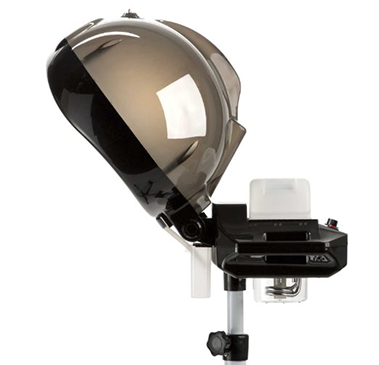
Salon Sundry Professional Salon Hair Steamer with Rolling Floor Stand Base
The Salon Sundry Professional Salon Steamer is lightweight, stainless steel, and has 650 watts of heating power; you are sure to love this hooded steamer. It has adjustable heights and wheels so it is easy to move. This steamer has two power levels, a swiveling hood, and is designed to work with regular tap water. This steamer is under $100, making it affordable compared to other steamers.
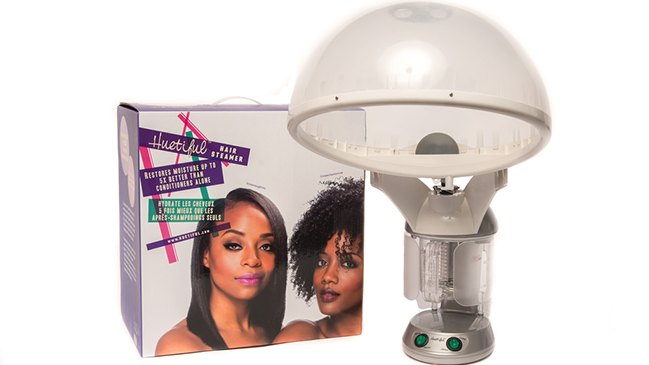
Huetiful Hair Steamer
These have become hugely popular with curlies and naturals. They are designed for our unique waves, curls, and coils and claims to restore moisture to dry hair five times better than any leading deep conditioner. This portable dual hair and facial steamer is a gem and is always in high demand so you have to get it while it is available. It has gone down in price over the last few years and depending on whether you are in the states or in Europe you can get it for under $150.
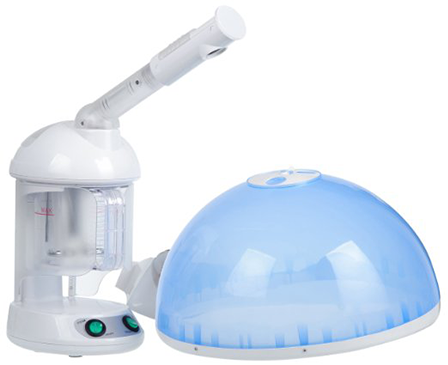
Secura S-192 Hair and Facial Steamer
If Huetiful is too rich for your blood and wallet, then you may want the other table-top steamer on the list. This hair and facial steamer is hugely popular, has a built-in ozone generator, and boasts of improving the absorption of conditioners and other treatments. They also claim it can be used for interior humidifying so for under $100 you really get a 3-1 steamer with this beauty.
Do you have a hooded steamer?



